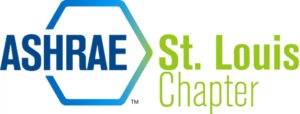Meeting, Monday, Feb 13, 2023, 4:15 PM – 7 PM
REGISTER NOW
NETWORKING/REGISTRATION: 4:15-4:45 PM
SESSION 1: 4:45PM-5:45PM The Future of Refrigerants – Change is all Around Us, Jay Eldridge
SESSION 2 6:00 – 7:00 PM Refrigerant Retrofits, John Whithouse
WHERE: In Person & Virtual Attendance, Westport Sheraton Chalet Matterhorn Ballroom. 191 W Port Plaza Dr, St. Louis, MO 63146
Signing up for the “in-person” option and not showing or canceling after the prior Thursday will result in a $25 fee
FEE $0 for ASHRAE St. Louis Members, Past Presidents, and full-time students; $25 for Non-members
SPEAKERS

Jay Eldridge, Regional Applied Equipment Sales Manager, Daikin Applied.
Jay has over 30 years’ experience in the application and design of applied HVAC systems. His current responsibilities include working with customer and engineers on applied systems.
Jay is a long time ASHRAE member and served as the chair of the District Energy (TC 6.2) technical committee and the Large Building Air-Conditioning Systems (TC 9.01) committee. He’s still sits on both committees. He is also a member of the Fans technical committee (TC 5.1) Jay has a degree in Mechanical Engineering from Iowa State University.
John Whithouse, Senior Principal Engineer, Sporlan Division – Parker Hannifin Corp.
John Withouse is the Senior Principal Engineer for the Sporlan Division of the Parker Hannifin Corporation. John has extensive experience in design, development, testing, and application of many types of super-market and other commercial refrigeration equipment. He is also highly experienced with system components including compressors, heat exchangers, pumps, fans, expansion valves, pressure regulating valves and system protection components.
During the past decade, John has specialized on refrigerants, both from the regulatory and technical standpoints. He is very familiar with both legacy and new products, including synthetic and natural low-GWP refrigerants, and their thermodynamics, material compatibility, and system chemistry.
John has a Strong background on refrigerant and chemical environmental regulations, at the global, national, international, and state/local levels. He has created material for and trained internal and external customers on refrigerant regulations and alternate refrigerants and their applications. A three time ASHRAE Journal-published author, John has also participated in standards-writing groups within ASHRAE, AHRI, and UL.
A graduate of Missouri S&T with a BSME, John previously enjoyed lengthy employment as Project Engineer, in the R&D department, with a major refrigerated case manufacturer in the St. Louis area.
Topics
The Future of Refrigerants – Change is all Around Us
Questions to be Addressed
• Why is HVAC&R industry changing refrigerants?
• How are refrigerants classified in ASHRAE Standard 34?
• Are safety standards, model building codes and local building codes ready?
• When are governments transitioning to lower GWP refrigerants in HVAC sector?
• How do A2L refrigerants compare to A1 refrigerants?
• How have safety standards changed to accommodate safe transition to A2Ls?
• What’s the myth about GWP?
• Why have some OEMs selected R454B to replace R410A?
• Will R513A be the ultimate replacement for R134a?
• Why is an OEM pushing R514A pretty hard to replace R123?
• Where can I get additional information on this transition?
Refrigerant Retrofits
In recent years, new refrigerants have been frequently introduced to the air conditioning and refrigeration industry. This is a result of the legislative changes enacted due to the Montreal Protocol and the Kigali Amendment and other directives. Concerns regarding ozone depletion and global warming have mandated these actions.
As new refrigerants are introduced, others are eliminated from the supply chain. System retrofits and complete super-market remodels soon follow. It is important to make sure critical system components like thermostatic expansion valves continue to control super-heat, solenoid valves continue open or close, along with appropriate refrigerant distribution and correct line sizes. These are important system functions that need to continue following the switch from the existing refrigerant to the new, environmentally friendly version.
Please join us for this session on Refrigerant Retrofits. Your participation will help you to be prepared to handle the next refrigerant retrofit project.











